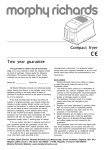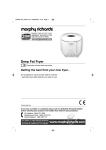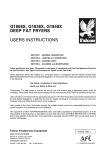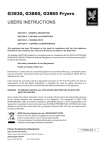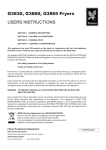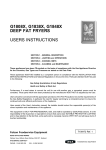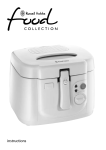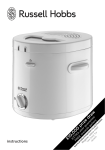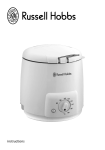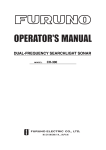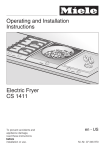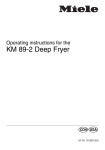Download Miele KM89-2 Operating instructions
Transcript
Operating instructions Deep fat fryer KM 89-2 It is essential to read these operating instructions before installing or using the machine, to avoid the risk of accident or damage to the machine. @Q\ä} M.-Nr. 03 999 340 Contents Contents Help to protect our environment. . . . . . . . . . . . . . . . . . . . . . . . . . . . . . . . . . . . . . 3 Description of the appliance . . . . . . . . . . . . . . . . . . . . . . . . . . . . . . . . . . . . . . . . . 4 Warning and Safety Instructions . . . . . . . . . . . . . . . . . . . . . . . . . . . . . . . . . . . . . 6 Before using for the first time . . . . . . . . . . . . . . . . . . . . . . . . . . . . . . . . . . . . . . . . 8 Frying . . . . . . . . . . . . . . . . . . . . . . . . . . . . . . . . . . . . . . . . . . . . . . . . . . . . . . . . . . . 9 Switching the fryer on . . . . . . . . . . . . . . . . . . . . . . . . . . . . . . . . . . . . . . . . . . . . . 9 Check the oil level. . . . . . . . . . . . . . . . . . . . . . . . . . . . . . . . . . . . . . . . . . . . . . . . 9 Correct procedure. . . . . . . . . . . . . . . . . . . . . . . . . . . . . . . . . . . . . . . . . . . . . . . . 9 After frying . . . . . . . . . . . . . . . . . . . . . . . . . . . . . . . . . . . . . . . . . . . . . . . . . . . . 10 Draining fat away . . . . . . . . . . . . . . . . . . . . . . . . . . . . . . . . . . . . . . . . . . . . . . . 10 Cooking chart . . . . . . . . . . . . . . . . . . . . . . . . . . . . . . . . . . . . . . . . . . . . . . . . . . 11 Safety cut-out switch. . . . . . . . . . . . . . . . . . . . . . . . . . . . . . . . . . . . . . . . . . . . . 12 Cleaning and Care . . . . . . . . . . . . . . . . . . . . . . . . . . . . . . . . . . . . . . . . . . . . . . . . 13 After Sales Service. . . . . . . . . . . . . . . . . . . . . . . . . . . . . . . . . . . . . . . . . . . . . . . . 14 Electrical connection and technical data. . . . . . . . . . . . . . . . . . . . . . . . . . . . . . 15 Appliance dimensions . . . . . . . . . . . . . . . . . . . . . . . . . . . . . . . . . . . . . . . . . . . . . 17 Instructions for building-in . . . . . . . . . . . . . . . . . . . . . . . . . . . . . . . . . . . . . . . . . 18 Help to protect our environment Help to protect our environment Disposal of packaging The transport and protective packing is mostly manufactured from the following re-usable materials: . . . Corrugated paper / card - mostly from recycled materials. . . . Polyethylene foil (PE) partly from secondary raw materials. Disposal of your old machine Old machines contain materials which can be recycled. Please contact your local authorities or scrap merchant about potential recycling schemes, before disposing of the appliance. Read the notes on page 6 before disposing of the appliance. Rather than just throwing these materials away, please take them to the nearest local authority collection point for specific waste. 3 Description of the appliance Description of the appliance 4 3 2 5 1 6 7 11 10 9 8 4 Description of the appliance Description of the appliance b Control panel c Basket handle (fold-away, removable) d Frying basket with hanging facility e Lid f Heating element hinge Data plate Because the data plate is no longer visible once the appliance has been built in a 2nd data plate is supplied which should be stuck into the space provided on page 12 of these instructions under After Sales Service. with basket hanging support g Heating element h Connection cable with plug, approx. 1.10 m long. N.B. plug according to country. i Drain tap j Control for On / Off and temperature selection k White indicator light = Operation l Yellow indicator light = Heating 5 Warning and Safety Instructions Warning and Safety Instructions This appliance complies with all relevant legal safety requirements. Improper use of the appliance can, however, present a risk of both personal injury and material damage. Before installation and before using the appliance for the first time read the operating instructions carefully. They give information on safety, on the operation and care of the appliance. This way you will avoid the risk of accidents and damage to the appliance. This appliance is intended for domestic use. Should it be installed for commercial use the relevant regulations must be observed. For safety reasons, this appliance must only be operated as a built-in appliance. This is necessary to ensure that all electric components are shielded. The electrical safety of the appliance can only be guaranteed when continuity is complete between the appliance and an effective earthing system which complies with local and national regulations. It is most important that this basic safety requirement is regulary tested by a qualified electrician. The manufacturer can not be held responsible for the consequences of an inadequate earthing system. Installation work and repairs may only be carried out by suitably qualified and competent engineers to ensure safety. Repairs and other work by unqualified persons could be dangerous. 6 Do not connect the appliance to the mains electricity supply by an extension lead. Extension leads do not guarantee the required safety of the appliance. The distance between the deep fat fryer and a cooker hood should be at least: 650 mm. Please ensure that the domestic supply corresponds to the information on the machine’s data plate. The appliance is only completely isolated from the electricity supply when it is switched off at the wall socket, or the mains fuse is withdrawn. Do not pull by the mains cable, but by the plug when withdrawing the plug from the socket. The fryer should only be switched on when the lid has been taken off and it has been filled with oil. Never switch on the deep fat fryer when the heating elements are raised. This could set fire to easily inflammable objects near the deep fat fryer. Do not let small children touch the appliance during operation. Danger of burning. Supervise use of the deep fat fryer by the elderly or infirm. Never leave the deep fat fryer unattended while frying is taking place. Overheated oil or fat can catch light. On no account should there be an open flame in the vicinity. When using kitchen appliances connected to sockets near the deep fat fryer ensure that the cable cannot touch the hot fryer or the hot fat. This is a fire hazard. Warning and Safety Instructions Warning and Safety Instructions Always ensure that food is sufficiently cooked or reheated. Many factors will affect the overall cooking time, including the size and amount of food, its temperature and changes to the recipe. Some foods may contain micro organisms which are only destroyed by thorough cooking, therefore when cooking or reheating foods, e.g. poultry, it is particulary important that the food is fully cooked through. If in doubt select a longer cooking or reheating time. It is essential to ensure that food has been evenly and sufficiently heated, and to check that it is thoroughly cooked, turning during cooking if necessary. Frying oil should be changed after approx. 6 to 10 batches of food have been cooked. Oil containing impurities is liable to catch light. Change the oil, when . . . . . . it becomes very dark and thick. . . . it smells unpleasant and foams. . . . the oil begins to smoke at a temperature of 170°C or less. Do not fill hot oil into plastic containers. The plastic will melt. To protect the environment used cooking oils and fats should be disposed of with the household waste after they have cooled down. Oils and fats. . . . . . should not be disposed of down the sink. . . . they can block up the water pipes. . . . and can damage the walls of waste pipes. Under no circumstances use a steam-cleaning appliance to clean the extractor. The steam could penetrate to live components and cause a short circuit. In countries which may be subject to infestation by cockroaches or other vermin, pay particular attention to keeping the appliance and its surroundings in a clean condition at all times. Any damage which might be caused by cockroaches or other vermin will not be covered by the appliance guarantee. Keep these instructions in a safe place and pass them on to any future user. Disposal of discarded appliances Before disposal of an old appliance, turn off at the mains, disconnect and remove the appliance cable at both ends and render useless. This is intended to prevent the discarded appliance from being a hazard. The manufacturer cannot be held liable for damage caused by noncompliance with safety instructions. 7 Before using for the first time Before using for the first time Clean the deep fat fryer before using for the first time. Fill the oil reservoir with approx. 5 l of water and add a little washing up liquid. Turn the control in a clockwise direction to 130°C and bring the water to the boil. When it has started to boil turn the control back to ”0“. Drain the water through the drain tap into a heat tolerant container. Rinse the oil reservoir out with hot water. Remember to close the drain tap. Raise the heater element and dry the oil reservoir with a clean cloth. 8 Frying Frying To fry, remove lid and fill the oil reservoir to the level mark with 3 litres of clean vegetable oil or frying fat. The reservoir will take a maximum of 4 litres of fat. Fat should be cut up into small pieces first. When re-using fat which has solidified in the reservoir, make a hole in the solid fat as far as the element. When the temperature sinks below the level set, the heater elements heat up again and the indicator light comes on again. This process is repeated until the fryer is switched off. Check the oil level Check the oil level before adding the food to be fried. The correct oil level is between the two marks at the back of the reservoir. Melt at a temperature of 100°C. When all the fat has melted, set at the correct temperature. Never heat up the fryer without any fat in it and only ever use with the lid removed. Switching the fryer on Turn the control clockwise as far as it will go and then turn it back again. Do not force it as otherwise the control will break. Turn the control knob to the required temperature. The white indicator light = illuminates to show that the fryer is in operation. Correct procedure Before frying, wipe dry any damp food with a cloth. The higher the water content in the food, the greater the danger of the fat frothing over. Set the required temperature (see chart on page 10). When the yellow light goes out, lower the basket containing the food into the fat. If the fat froths a lot, briefly remove the food from the fryer. Never salt food over the oil. The yellow indicator light = illuminates when the fryer is heating up. The yellow indicator light goes out . . . when the set temperature has been reached. 9 Frying Frying After frying When the food is ready remove the basket and lightly shake to remove superfluous oil. In order to drain the fried food, the frying basket can be suspended from the bracket support of the heating element hinge. Turn the control back to ”0“. The indicator lights go out. Only replace the lid when the oil or fat has cooled. The frying basket has a handle which can be folded away when not in use: press the sides of the handle together and fold into the basket. The handle can be removed for cleaning the frying basket. Draining fat away Frying oil can normally be used for approx. 6-10 batches. Between each use, the oil should be poured through a metal sieve lined with kitchen paper, as oil containing impurities is liable to catch light. There is a drain tap under the base of the oil reservoir for draining away the oil and for draining away any water which has collected in the cold oil zone. Before draining off solid fat, turn the selector to the highest temperature to just liquefy the fat. Be careful not to burn yourself with oil or fat that is still hot. Let hot oil cool down to a safe level, but still remain liquid before draining. Place a suitable container able to withstand heat under the drain tap. Open the tap by turning the lever 90° to the right. To close the tap turn the lever as far as possible to the left. 10 Frying Frying Cooking chart Food Temperature in °C Time in mins Fish Fillets (Battered) 180 6-7 Whitebait 180 4 Scampi (Breaded) 180 4 Chicken Drumsticks 170 16 - 18 Scotch Eggs 180 6-7 Stuffed Mushrooms 180 3 Camembert (Breaded) 170 5 Potato Croquettes 180 4 Chips 180 4-5 Crisps 180 3 Choux Pastry Puffs 190 4-5 Apple Fritters 190 6 Doughnuts 180 5 Please Note: The times given should serve only as a guide - the actual cooking time will depend on the size and quantity of food cooked. 11 Frying Safety cut-out switch Your fryer is fitted with a safety cut-out which automatically switches it off if: – the oil reservoir is not filled to at least the lower level indicator. – the fryer is switched on when empty. – the fryer is switched on when the heating element has been raised (e.g. for cleaning). The fryer has cut out automatically when neither the heating indicator light nor the operating indicator light is on and the oil is no longer being heated. 12 Turn the control to ‘0’ and wait until the heating element has cooled down. Rectify whatever has caused the automatic cut-out. Press the pin (see arrow) situated underneath the front of the fryer in firmly. The fryer can now be used again. Cleaning and Care Cleaning and Care The lid / oil reservoir / frying basket These can all be cleaned using hot water with a little mild washing up liquid. The lid and basket can be cleaned in a dishwasher. On no account use abrasive cleaning agents, scouring powder, knives or hard brushes or anything abrasive. Facia panel / Control knobs Do not use any scouring agents or pads on the knobs or facia, as these could cause damage. Clean the control knobs and the facia panel with hot water and a little washing up liquid. After cleaning rub dry with a soft cloth. See section on ”Operation“ for how to drain away the oil before cleaning the oil reservoir. To clean the oil reservoir the heating element can be swung out and then fixed with the fixing bar to the element hinge. To clean use a suitable proprietary stainless steel cleaning agent. 13 After Sales Service After Sales Service In the event of any fault which you cannot correct yourself, or if the appliance is under guarantee, please contact: Your Miele Dealer or The Miele Service Department The address of the nearest Service Department is given on the back page. When contacting the Service Department, please quote the Model and Serial No. of the appliance. both of which can be found on the data plate. Space for data plate supplied 14 Electrical connection and technical data Electrical connection and technical data Electrical connection General notes Electrical connection of the appliance should be undertaken by a qualified electrician in strict accordance with national and local safety regulations. This appliance conforms to EN 55014. For extra safety it is advisable to install a residual current device (RCD), with a trip current of 30 mA. Electrical connection U.K., AUS (IRL, NZ, ZA) The appliance is supplied for connection to an a.c. single phase 240 V (230 V), 50 Hz supply. Connection should be made by a fused plug (U.K. only) and switched socket. The On-Off switch should be easily accessible after the appliance has been built-in. The data plate gives the necessary data for connection. See page 13. Important: The wires in the mains lead are coloured in accordance with the following code: Green/yellow = earth Blue = neutral Brown = live As the colours of the wires in the mains lead of this appliance may not correspond with the coloured makings identifying the terminals in your plug, proceed as follows: The wire which is coloured green and yellow must be connected to the terminal in the plug which is marked with the letter E or by the earth symbol z or coloured green or green and yellow. The wire which is coloured blue must be connected to the terminal which is marked with the letter N or coloured black. For U.K.: The wire which is coloured brown must be connected to the terminal which is marked with the letter L or coloured red. For Australia: The wire which is coloured brown must be connected to the terminal which is marked with the letter A or coloured red. WARNING THIS APPLIANCE MUST BE EARTHED 15 Electrical connection and technical data Electrical connection and technical data Non-rewireable plugs BS 1363 (U.K.) Technical data If this machine or appliance is fitted with a non-rewireable plug, the following information applies: Total connected load – U.K., AUS . . . . . . . . . . . . . . . . 2940 W – IRL, NZ, ZA . . . . . . . . . . . . . . . 2700 W If the socket outlets are not suitable for the plug supplied with this product, it must be cut off and an appropriate plug fitted. Electrical connection – U.K., AUS . . . . . . . . . . ~ 50 Hz 240 V – IRL, NZ, ZA . . . . . . . . . ~ 50 Hz 230 V The plug cut from the flexible cord should be disposed of and on no account be inserted into a 13A socket elsewhere in the house (electric shock hazard). The fuse cover must be re-fitted when changing the fuse, and if the fuse cover is lost, the plug must not be used until a suitable replacement is obtained. The colour of the correct replacement cover is that of the coloured insert in the base of the plug, or the colour that is embossed in words in the base of the plug (as applicable to the design of plug fitted). The correct fuse rating of the replacement fuses that are ASTA approved to BS 1362 should be fitted. Replacement fuse covers may be purchased from your local electrical suppliers, electricity showrooms, or Miele Service Agent. 16 Fuse rating – U.K., IRL . . . . . . . . . . . . . . . . . . . 13 A – ZA . . . . . . . . . . . . . . . . . . . . . . . . 10 A Plug rating – AUS, NZ . . . . . . . . . . . . . . . . . . . 15 A Connection cable . . . . . . . . . . . 1.10 m This appliance needs a 3 x 1.5 mm2 core cable, should the connection cable ever need to be replaced. Appliance dimensions Appliance dimensions 17 Instructions for building-in Instructions for building-in These hobs are classified as ”Y“ class for heat protection. There may be a wall at the rear and wall or tall units at one side. On the other side, however, no unit or divider must stand higher than the appliance. There must be a minimum distance of 30 mm between the hob and adjacent furniture, (e.g. tall unit) owing to the heat radiated from the elements. The distance between the deep fat fryer and cooker hood should be at least 650 mm. Ensure that the drain tap is accessible when the appliance is built in and that the fat can be safely drained away. Depth in mm Width (= Dimension B) in mm 490 490 490 490 490 265 558 851 1144 1437 490 490 490 560 1143 1728 One 2 zone + one 4 zone 490 851 Two 2 zone + one 4 zone 490 1143 Three 2 zone + one 4 zone 490 1437 One 2 zone + two 4 zone 490 1436 Two 2 zone + two 4 zone 490 1729 2 zone Combiset 1 element 2 elements 3 elements 4 elements 5 elements 4 zone Combiset 1 elements 2 elements 3 elements Combination Extractor (e.g. DA 8-2) For building in between two appliances: - Dimension B increases by 90 mm. Prepare the worktop cut-out as illustrated. Dimension ”B“ applies for a combination of appliances and is given on the chart. 18 For building in at the end of a combination: - Dimension B increases by 98 mm. Instructions for building-in Instructions for building-in Stick the seal provided f under the edge of the deep fat fryer. loosen When building-in several Combiset units, a spacer bar must be fitted between the units. It is supplied with its own installation instructions. tighten b Appliance c Tensioning screw d Clamp e Worktop f Seal Turn the tensioning screws c in the clamps on the appliance b in an anti-clockwise direction until a resistance is met and turn the clamps to the left. Place the appliance into position, turn the clamps and tighten the tensioning screws until the clamps press into the worktop e. Connect the appliance to the electricity supply. A gap the width of an appliance has to be assured between a gas hob and a deep fat fryer to avoid any source of ignition. 19 Alteration rights reserved / 003 AUS, GB, IRL, NZ, ZA - 2900 This paper consists of cellulose which has been bleached without the use of chlorine.




















